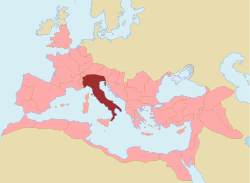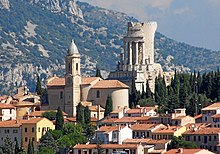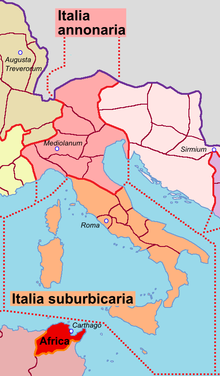Roman Italy
Italy Italia ( Latin) | |||||||||
|---|---|---|---|---|---|---|---|---|---|
 Roman Empire at its greatest extent c. 117 AD, with Italy in red and provinces in pink | |||||||||
| Capital | Rome: full-fledged until Diocletianic times, from then on mostly only de jure.
Late Antiquity | ||||||||
| Population | |||||||||
• AD 1 | Estimates vary from 4 to 10 million (c.1 million in Rome)[1][2] | ||||||||
| ISO 3166 code | IT | ||||||||
| |||||||||
| History of Italy |
|---|
 |
|
|
Italia (in both the
The consolidation of Italy into a single entity occurred during the
The period between the end of the 2nd century BC and the 1st century BC was
The
Characteristics
Following the end of the Social War in 87 BC, Rome had allowed its fellow Italian allies full rights in Roman society and granted Roman citizenship to all fellow Italic peoples.[16] After having been for centuries the heart of the Roman Empire, from the 3rd century the government and the cultural center began to move eastward: first the Edict of Caracalla in 212 AD, extended Roman citizenship to all free men within the Imperial boundaries. Christianity then began to establish itself as the dominant religion from Constantine's reign (306–337), raising the power of Eastern metropolises, later grouped into Pentarchy.
Although not founded as a capital city in 330,
History
The name Italia covered an area whose borders evolved over time. According to Strabo's Geographica, before the expansion of the Roman Republic, the name was used by Greeks to indicate the land between the strait of Messina and the line connecting the gulf of Salerno and gulf of Taranto (corresponding roughly to the current region of Calabria); later the term was extended by Romans to include the Italian Peninsula up to the Rubicon, a river located between Northern and Central Italy.
In 49 BC, with the , Slovenia) was the easternmost town of Italy.
Augustan organization
At the beginning of the Roman Imperial era, Italy was a collection of territories with different political statuses. Some cities, called


- Regio I Latium et Campania
- Regio II Apulia et Calabria
- Regio III Lucania et Bruttium
- Regio IV Samnium
- Regio V Picenum
- Regio VI Umbria et Ager Gallicus
- Regio VII Etruria
- Regio VIII Aemilia
- Regio IX Liguria
- Regio X Venetia et Histria
- Regio XI Transpadana
Italy was privileged by Augustus and his heirs, with the construction, among other public structures, of a dense network of Roman roads. The Italian economy flourished: agriculture, handicraft and industry had a sensible growth, allowing the export of goods to the provinces.[21] The Italian population may have grown as well: three census were ordered by Augustus, also assuming role of Roman censor, in order to record the number of Roman citizens throughout the empire. The surviving totals were 4,063,000 in 28 BC, 4,233,000 in 8 BC, and 4,937,000 in AD 14, but it is still debated whether these counted all citizens, all adult male citizens, or citizens sui iuris.[22] Estimates for the population of mainland Italy, including Cisalpine Gaul, at the beginning of the 1st century range from 6,000,000 according to Karl Julius Beloch in 1886, to 14,000,000 according to Elio Lo Cascio in 2009.[23]
Diocletianic and Constantinian re-organizations
During the Crisis of the Third Century the Roman Empire was on the verge of disintegration under the combined pressures of invasions, military anarchy and civil wars, and hyperinflation. In 284, Emperor Diocletian restored political stability. He carried out thorough administrative reforms to maintain order. He created the so-called Tetrarchy whereby the empire was ruled by two senior emperors called Augusti and two junior vice-emperors called Caesars. He decreased the size of the Roman provinces by doubling their number to reduce the power of the provincial governors. He grouped the provinces into several dioceses (Latin: diocesis) and put them under the supervision of the Imperial vicarius (vice, deputy), who was the head of the diocese. During the Crisis of the Third Century the importance of Rome declined because the city was far from the troubled frontiers. Diocletian and his colleagues usually resided in four Imperial seats. The Augusti, Diocletian and Maximian, who were responsible for the East and West respectively, established themselves at Nicomedia, in north-western Anatolia (closer to the Persian frontier in the east) and Milan, in northern Italy (closer to the European frontiers) respectively. The seats of the Caesars were Augusta Treverorum (on the River Rhine frontier) for Constantius Chlorus and Sirmium (on the River Danube frontier) for Galerius who also resided at Thessaloniki.
Under Diocletian Italy became the Dioecesis Italiciana. It included Raetia. It was subdivided the following provinces:
- Liguria (today's Liguria and western Piedmont)
- Transpadana (eastern Piedmont and Lombardy)
- Rhaetia (eastern Switzerland, western and central Austria, part of southern Germany, and part of northeastern Italy)
- Venetia et Histria (today's Trentino-Alto Adige and Istria county)
- Aemilia (Emilia-Romagna)
- Tuscia (Etruria) et Umbria (Tuscany and Umbria)
- Flaminia (Picenum and the former Ager Gallicus, in today's Marche)
- Latium et Campania (the coastal parts of Lazio and Campania)
- Samnium (Abruzzo, Molise and Irpinia)
- Apulia et Calabria (today's Apulia)
- Lucania et Bruttium (Basilicata and Calabria)
- Sicilia (Sicily and Malta)
- Corsica et Sardinia

Constantine subdivided the Empire into four praetorian prefectures. The Diocesis Italiciana became the Praetorian prefecture of Italy (praefectura praetoria Italiae), and was subdivided into two dioceses. It still included Raetia. The two dioceses and their provinces were:
Diocesis Italia annonaria (Italy of the
- Alpes Cottiae (modern Liguria and western part of Piedmont)
- Liguria (western Lombardy and eastern part of Piedmont)
- Venetia et Histria (Trentino-Alto Adige, Venetoand eastern and central Lombardy)
- Raetia I (eastern Switzerland and western Austria)
- Rhaetia II (central Austria, part of southern Germany, and part of northeastern Italy)
- Aemilia (the Emilia part of Emilia-Romagna)
- Flaminia et Picenum Annonarium (Romagna and northern Marche)
Diocesis Italia suburbicaria (Italy "under the government of the urbs", i.e. Rome)
- Tuscia (Etruria) et Umbria (Tuscany, Umbria and the northern part of coastal Lazio)
- Picenum suburbicarium (Piceno, in southern Marche)
- Valeria Sabina (the modern province of Rieti, other areas of Lazio and areas of Umbria and Abruzzo)
- Campania (central and southern coastal Lazio and coastal Campania except for the modern province of Salerno)
- Samnium (Abruzzo, Molise and the mountain areas of modern Campania; i.e., the modern provinces of Benevento and Avellino and part of the province of Caserta)
- Apulia et Calabria (today's Apulia)
- Lucania et Bruttium (modern Calabria, Basilicata and the province of Salerno in modern Campania)
- Sicilia (Sicily and Malta)
- Sardinia
- Corsica
Late Antiquity
In 330,

According to
In 476, with the abdication of
References
- ^ Journal of Roman Archaeology, Volume 18, Part 1
- ISBN 978-9004171183.
- ISBN 9781400854899.
- ^ Hannibal's war, by J. F. Lazenby
- ISBN 9780241003909.
- ^ Rogers, Lester Burton; Adams, Fay; Brown, Walker (1956). "Story of Nations".
- History of Rome, Book II: From the Abolition of the Monarchy in Rome to the Union of Italy. Leipzig: Reimer & Hirsel.
- ^ A. Fear; P. Liddel, eds. (2010). "The Glory of Italy and Rome's Universal Destiny in Strabo's Geographika". Historiae Mundi. Studies in Universal History. London: Duckworth. pp. 87–101. Retrieved 20 November 2021.
- ISBN 9780709931218. Retrieved 20 November 2021.
- ISBN 9788896543092. Retrieved 20 November 2021.
- ISBN 9780241003909. Retrieved 20 November 2021.
- ISBN 9781472519801. Retrieved 20 November 2021.
- ISBN 9781472519801. Retrieved 20 November 2021.
- ^ "Antico appellativo dell'Italia romana: Italia Omnium Terrarum Parens" (in Italian). Retrieved 20 November 2021.
- ^ Video of Roman Milan (in Italian)
- ISBN 9781904675372.
- ^ Cassius, Dio. Historia Romana. Vol. 41. 36.
- ^ Laffi, Umberto (1992). "La provincia della Gallia Cisalpina". Athenaeum (in Italian) (80). Firenze: 5–23.
- ^ a b Aurigemma, Salvatore. "Gallia Cisalpina". www.treccani.it (in Italian). Enciclopedia Italiana. Retrieved 14 October 2014.
- ^ "Italy (ancient Roman territory)". britannica.com. Encyclopædia Britannica. Retrieved 10 November 2013.
- ^ Rostovtzeff, Michael (1957). The social and economic history of the Roman Empire. Vol. 1 (2 ed.). Oxford: Clarendon Press. pp. 73–74.
- ^ Hin, Saskia (2007). Counting Romans (PDF). Leiden: Princeton/Stanford Working Papers.
- ISBN 9780199562596.
- ISBN 9788873953609.
Further reading
- ISBN 0-520-06975-7.
- ISBN 978-0801414381.
- Whatmough, Joshua (1937). The Foundations of Roman Italy. London: Methuen & Company. ISBN 9780598820341.
- Lomas, Kathryn (1996). Roman Italy, 338 BC-AD 200. New York: St. Martin's Press. ISBN 978-0-312-16072-2.
- Launaro, Alessandro (2011). Peasants and Slaves: The Rural Population of Roman Italy. Cambridge University Press. ISBN 978-1107004795.
- Hin, Saskia (2013). The Demography of Roman Italy. Cambridge University Press. ISBN 978-1-107-00393-4.
- Clarke, John R. (1991). The Houses of Roman Italy, 100 BC-AD 250. Berkeley: University of California Press. ISBN 0-520-07267-7.
- Laurence, Ray (2002). The Roads of Roman Italy: Mobility and Cultural Change. London: Routledge. ISBN 0-415-16616-0.
External links
- (in Italian) Geographical regions in Roman history: Italy


